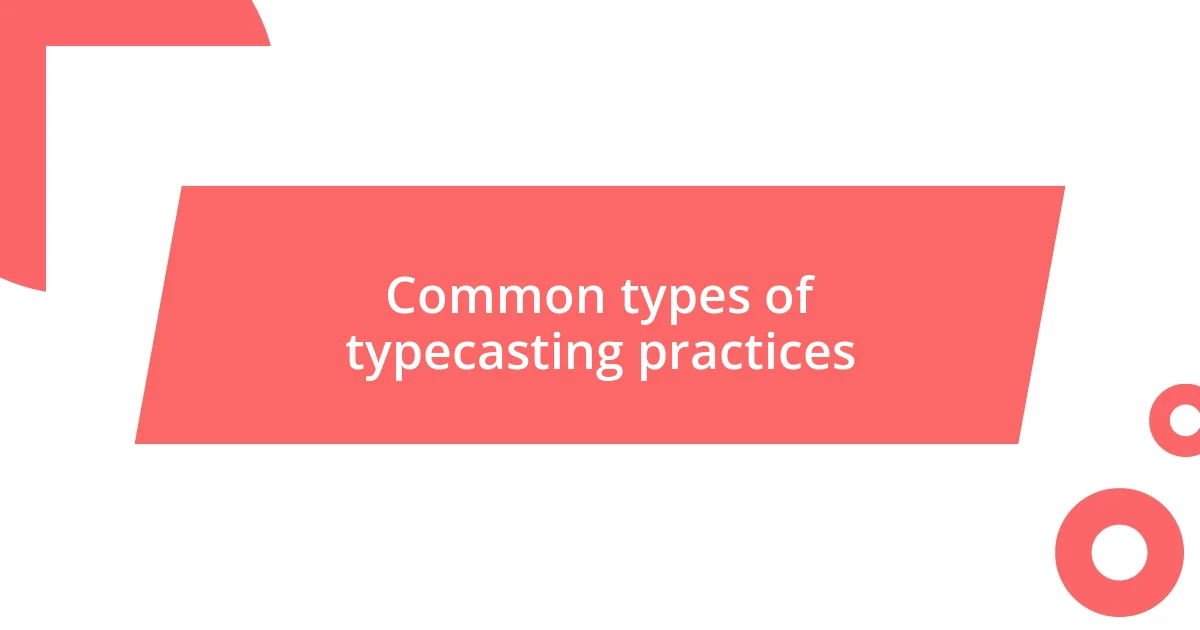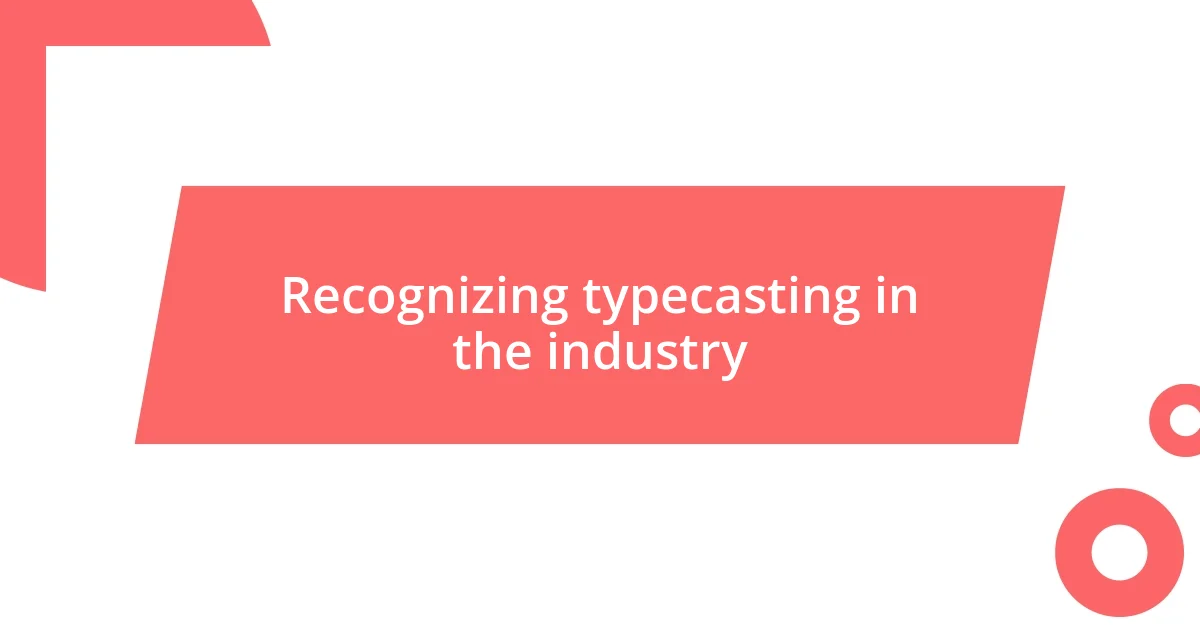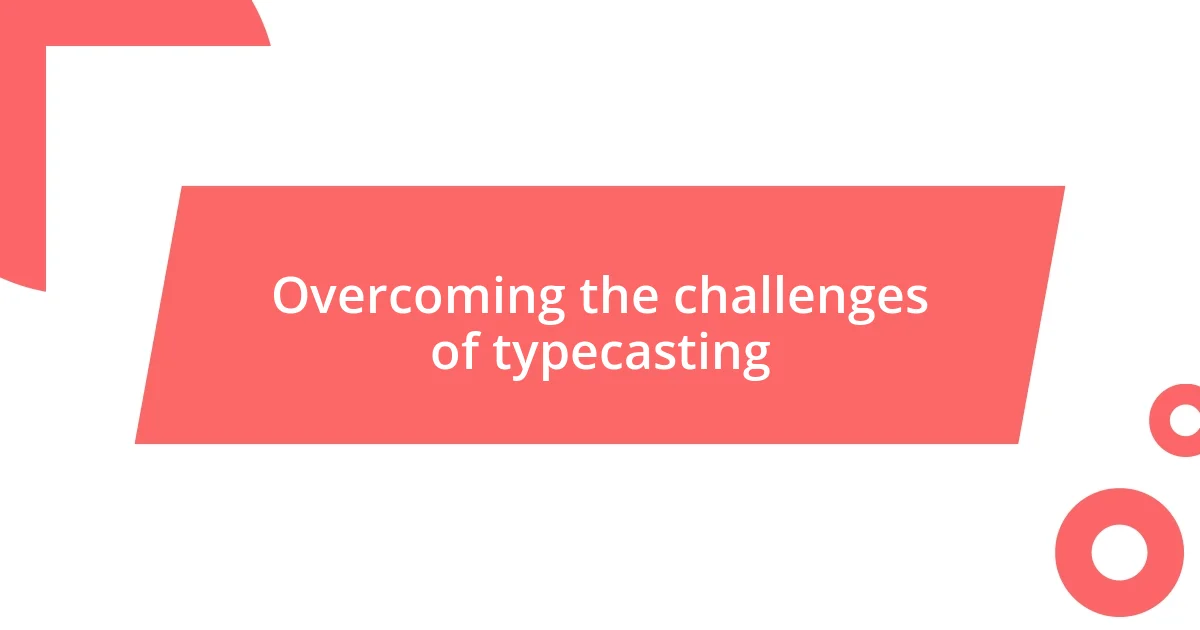Key takeaways:
- Typecasting can trap actors in specific roles, limiting their careers and emotional expressions while affecting storytelling diversity in the industry.
- Actors can combat typecasting through self-awareness, networking, and seeking diverse roles to showcase their versatility and artistic growth.
- Embracing versatility in acting roles allows actors to broaden their skills, connect deeply with audiences, and redefine their career trajectories.

Understanding the concept of typecasting
Typecasting refers to the phenomenon where an actor becomes strongly associated with a specific character type, limiting their opportunities to explore diverse roles. I’ve watched many talented actors struggle against this creative confinement. For example, I remember seeing a beloved comedian transition into a dramatic role, and while I was excited to see their range, the audience struggled to see past the humor they were known for. Isn’t it fascinating how our perceptions can shape an actor’s career?
In my experience, typecasting can have emotional repercussions for the actors involved. I once spoke with a friend who had landed a role that fit their initial breakout character perfectly, but over time, it felt like a double-edged sword. They expressed frustration at being pigeonholed, almost feeling trapped in a box that fans and producers alike refused to let them out of. Can you imagine the pressure they felt to live up to a version of themselves that wasn’t the whole story?
It’s intriguing to consider how typecasting also affects the storytelling landscape. When certain actors are repeatedly cast in the same roles, writers might miss out on crafting fresh narratives that challenge societal norms or explore new ideas. I often wonder how many compelling stories remain untold simply because an audience can’t envision an actor outside their established persona. This cyclical nature of typecasting can stifle creativity for everyone involved, making me question: how can we, as viewers, expand our perspectives and give actors the freedom to evolve?

Impacts of typecasting on actors
Typecasting can significantly limit an actor’s career trajectory. From my observations, many talented individuals find themselves repeatedly auditioning for the same type of roles simply because they’ve been successful in those characters before. I once attended a film festival where a well-known actor expressed their dismay about being offered roles that didn’t excite them anymore. Seeing their passion fade was quite disheartening, reminding me that actors are not just performers but creators whose artistic journeys deserve exploration.
The impacts of typecasting ripple beyond career stagnation, affecting an actor’s mental health. Here are a few key points to consider:
- Frustration and Disillusionment: Many actors become frustrated when they can’t break free from a singular identity.
- Loss of Passion: Continuous typecasting can lead to burnout, diminishing their love for the craft.
- Public Perception: Fans may struggle to accept them in varied roles, which can be isolating for the actor.
- Creative Stagnation: This confinement not only hinders the actor but can also limit the creative possibilities for writers and directors.
Reflecting on this, I think it’s vital for both the industry and the audience to embrace the multifaceted nature of actors. We need to foster an environment where they can explore their full potential, paving the way for richer stories and compelling performances.

Common types of typecasting practices
Typecasting practices can manifest in various forms, each influencing an actor’s career in unique ways. I often reflect on those instances where certain actors are consistently cast in roles that align with their real-life persona. For example, I once watched a documentary about an actor who always played the charming boyfriend. This typecasting seemed to resonate with the audience, but it left the actor yearning for a chance to explore more complex and challenging characters, creating an emotional disconnect between their true self and the roles they were offered.
Another prevalent practice I’ve seen involves geographical or cultural typecasting. An actor with a specific ethnic background may find themselves primarily auditioning for roles that fit a narrow stereotype. I remember discussing this issue with a talented actress at a convention who shared her experiences of being offered roles that didn’t align with her skills or interests. It was her perspective that resonated most; while she deeply cherished her heritage, she felt frustrated that it became a crutch hindering her opportunities to showcase her versatility.
Lastly, there’s the age-based typecasting I find particularly disheartening. Actors, regardless of their age, can find themselves stuck in roles that don’t reflect their current capabilities. I once spoke to a seasoned actor who mentioned how they were often only offered roles catering to the “older generation,” despite being full of youthful energy. It’s a tough reality to face when you want to challenge the status quo but feel boxed in by industry perceptions.
| Typecasting Practice | Description |
|---|---|
| Role Types | Actors repetitively cast in similar roles, limiting diversity. |
| Cultural/Stereotypical | Actors typecast based on ethnicity, missing varied opportunities. |
| Age-Based | Actors restricted by age-related expectations in roles they can assume. |

Recognizing typecasting in the industry
Recognizing typecasting in the industry requires keen observation of casting patterns and the stories behind them. I’ve often seen actors who excel in a particular genre struggle to branch out simply because that’s what audiences expect of them. I remember chatting with a friend who’s an aspiring actor, and he mentioned how difficult it is to convince casting directors that he can play a dramatic role when he’s primarily been seen in light-hearted comedies. Isn’t it frustrating when talent is overshadowed by a label?
One of the most telling signs of typecasting is the overwhelming similarity in the characters actors portray. I attended a panel discussion where a panelist reflected on his experience of being typecast as the “tough guy.” While he embraced the roles, he confided that he’d love to portray a more vulnerable character. It made me wonder—what does it take for an actor to break free from that mold? In many instances, it means challenging both industry standards and audience perceptions.
Moreover, the impact of social media on typecasting cannot be overlooked. I recall scrolling through Instagram and noticing how certain actors’ posts often depict them in stylized versions of their “typecast” roles. This feeds into a cycle where fans only recognize them in specific contexts, leading to a narrow view of their capabilities. If audiences continue to see them through this limited lens, how can we expect the industry to evolve?

Overcoming the challenges of typecasting
Overcoming the challenges of typecasting can feel like climbing a mountain, but I believe it starts with self-awareness and determination. I vividly remember an actor friend of mine who was struggling with being cast only in comedic roles. He decided to take matters into his own hands; he began enrolling in workshops focused on dramatic acting. Through sheer will and commitment, he broadened his skill set and eventually landed a role that showcased his range. Isn’t it inspiring to see someone take control of their narrative?
Networking plays a pivotal role in breaking free from typecasting as well. I’ve been fortunate to witness actors collaborating on passion projects outside the mainstream, which helps to redefine their public personas. For instance, a colleague of mine directed a short film centered on complex characters, casting his friends who had been routinely pigeonholed. The outcome was remarkable—not only did they shine in their roles, but it also opened doors to more varied opportunities afterward. It made me ponder, how often do artists miss out by not taking the leap to create their own paths?
Lastly, seeking out diverse roles and constantly challenging oneself is crucial. I recall a powerful moment when a well-known actor received a standing ovation for taking on a role unlike anything he’d done before. It was clear to everyone that he poured his heart into that performance. Watching that unfold reaffirmed my belief that sometimes, all it takes is one brave move to counteract preconceived notions. How can we, as advocates of the arts, encourage actors to push past those boundaries? Maybe the answer lies in celebrating risk-taking and advocating for artistic growth.

Strategies for avoiding typecasting
Finding strategies to avoid typecasting is essential for any actor aiming to showcase their full potential. One effective method is diversifying one’s skill set. I remember attending a workshop where actors were encouraged to perform outside their comfort zones. Watching my peers present various types of characters was refreshing and reminded me how essential it is to stretch our capabilities. It got me thinking—when was the last time you challenged yourself in a new way?
Another vital approach is crafting a personal brand that reflects versatility. I once had a conversation with a casting director who mentioned how actors could shape their narratives through their portfolios and social media. By showcasing a range of performances and styles, actors can redefine how they are perceived. I often wonder if we underestimate the power of storytelling in shaping our identities—couldn’t we all benefit from sharing more of our journeys?
Lastly, being proactive in selecting roles is crucial. I know an actress who purposefully sought out independent films that offered rich, complex characters unlike those she typically portrayed. She emphasized that while it was risky, the experience was transformative and allowed her to break free from what was expected. Isn’t it fascinating how a single bold choice can lead to unexpected doors opening?

Embracing versatility in acting roles
Embracing versatility in acting roles has always resonated with me, especially when I think about the transformative power of stepping into different characters. There was a time when I took on a role completely outside my usual type; I remember the thrill I felt during rehearsals, discovering layers of a character that challenged my perceptions of acting. It made me realize that versatility is not just about changing roles—it’s about expanding our emotional vocabulary as artists.
One of my fondest memories is attending a performance where an actor, known for his action-packed films, took a courageous leap into a heart-wrenching dramatic role. His portrayal was so moving that it brought tears to my eyes. That experience sparked a profound admiration for the courage it takes to break free from the familiar and dive into the unknown. Isn’t it incredible how those moments of bravery can resonate with audiences and redefine an actor’s career?
I’ve often pondered how embracing versatility can deeply connect us with our audience. For example, an actress I know portrayed a series of diverse roles that spanned different genres and backgrounds. Each performance seemed to peel back a layer of her own identity, allowing her to share parts of herself that were hidden. Watching her journey made me question, doesn’t every individual share a unique story? And isn’t acting, at its core, about revealing those stories in ways that inspire and challenge both ourselves and others?















